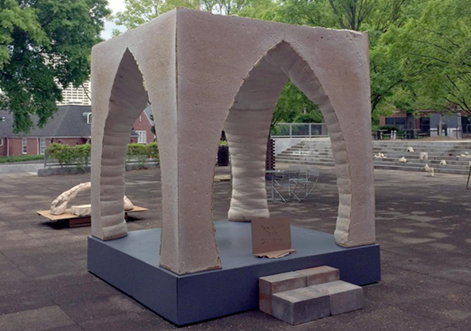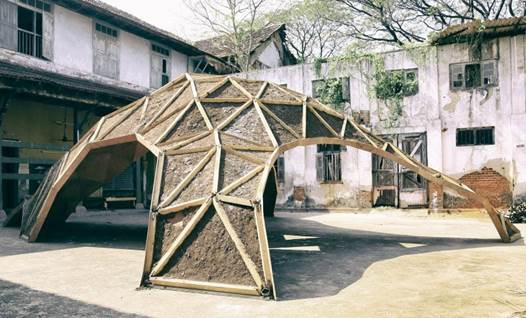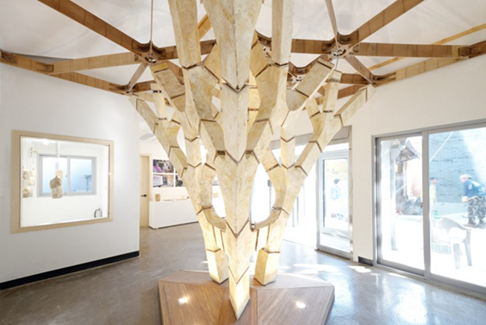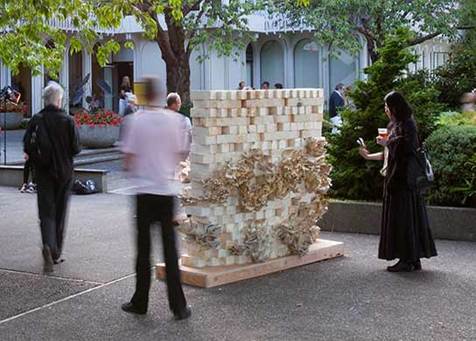ShodhKosh: Journal of Visual and Performing ArtsISSN (Online): 2582-7472
|
|
A review of Mycelium-based Bio-Composites and their possible application in Architecture
Jaykumar Patel 1![]()
![]() , Jitendra Sharma 2
, Jitendra Sharma 2![]()
![]()
1 Research
Scholar, Faculty of Design & Arts, Poornima University, India
2 Professor, Faculty of Design & Arts, Poornima University, India
|
|
ABSTRACT |
||
|
Construction
industry is one of the largest consumers of natural resources, and so faces
enormous difficulties in reducing the environmental impact of existing
consumption habits. Growing industry demand for biodegradable or alternative
materials and products derived from renewable resources, has recently
prompted researchers from diverse fields to work in this area. They are
working to find sustainable alternatives and develop natural bio-composites
to replace various petroleum-based products in the interest of the
environment. One such bio-composite derived from mycelium can provide a
renewable and biodegradable alternative to conventional building materials.
Mycelium, the fibrous root system of fungi, grows on organic substrates under
controlled environmental conditions to produce these biomaterials. This
article provides a comprehensive analysis of the current research and
applications of mycelium-based materials in the field of architecture. |
|||
|
Received 15 May 2023 Accepted 14 December 2023 Published 20 December 2023 Corresponding Author Jaykumar
Patel, pj.pateljay@gmail.com DOI 10.29121/shodhkosh.v4.i2SE.2023.676 Funding: This research
received no specific grant from any funding agency in the public, commercial,
or not-for-profit sectors. Copyright: © 2023 The
Author(s). This work is licensed under a Creative Commons
Attribution 4.0 International License. With the
license CC-BY, authors retain the copyright, allowing anyone to download,
reuse, re-print, modify, distribute, and/or copy their contribution. The work
must be properly attributed to its author.
|
|||
|
Keywords: Mycelium, Building Materials, Sustainable
Architecture, Biodegradable Material, Bio-Composite |
|||
1. INTRODUCTION
According to a study conducted by Ghazvinian et al.
(505-513), the United Nations has projected that by the year 2050, almost 68%
of the global population will reside in urban areas. This significant
urbanisation trend is expected to result in a surge in the need for housing. The construction industry, including the
building sector, accounts for 38% of all energy-related CO2 emissions Almpani-Lekka
et al. (2022). This growth in population and urbanization
has led to a need for sustainable, sustainable, and eco-friendly solutions in
the construction industry. The focus is now on developing, designing, and using
eco-friendly building materials that use low-impact components throughout their
life cycle Almpani-Lekka
et al. (2022). Bio-design research
offers potential solutions to environmental challenges caused by the
fast-growing population and discard culture. Bio-design methods involve
biology-inspired approaches to design and production, with live organisms
playing a significant role Ghazvinian
et al. (2019). Current developments
in technology, biology, and digital computation capacities have led to the
creation of alternative materials and fabrication procedures Attias et al. (2017). Mycelium-based
composites are renewable and biodegradable materials that can be used in
various design and production processes, including architectural applications Ghazvinian
et al. (2019). These materials
self-grow, fix themselves, clean up waste, adapt to the environment, have low
production and operating costs, and can be returned to nature when no longer
needed Adamatzky
et al. (2019). Mycelium serves as an
organic self-assembling glue when growing into a substrate, creating a dense
composite made of biopolymers like cellulose and chitin Sydor et al. (2021)
1.1. Mycelium based Materials
Mycelium is the living part of a fungus. It is made up of a number
of thread-like hyphae that branch out. Most of the time, it is found
underground or in other things like wood, soil, or dead organic matter.
Mycelium plays a crucial role in the ecosystem as it decomposes dead organic
matter, releasing nutrients back into the soil, which supports the growth of
other plants and organisms Ghazvinian
et al. (2019).
Mycelium-based materials have several advantages over traditional
materials such as plastics or wood. They are biodegradable, renewable, and can
be produced using low-energy and low-emission methods. Mycelium-based materials
can also be moulded into various shapes, making them versatile for different
applications. One popular use of mycelium-based materials is in packaging.
Mycelium can be grown into various shapes and sizes to create packaging that is
both biodegradable and compostable. Mycelium-based materials can also be used
in construction, textiles, and even as a leather alternative. Mycelium-based
materials are classified into two types: Pure mycelium is the result of
complete substrate degradation. Mycelium-based bio-composites, on the other
hand, are the result of mycelium hibernating or being killed during its growth
process. Fungal growth can be stopped during substrate colonisation by drying
or heating the material. Drying the mycelium causes it to hibernate, which
means the fungus is ready to resume growth when environmental conditions allow
it, whereas heating permanently stops the fungi's growth Ghazvinian
et al. (2019). Overall, mycelium-based materials are a
promising alternative to traditional materials that have negative environmental
impacts.
1.2. Fabrication Methods Used in Mycelium-based Composites
Growing mycelium in a mould with a predetermined geometry is the
most basic way for producing mycelium-based materials. Additive and subtractive
manufacturing are the two main ways that mycelium-based materials are made.
Subtractive processes can be used on both living and dead mycelium. Additive
manufacturing, on the other hand, is used to make low-density products or large
building parts that are already in place. The following are some of the common
fabrication methods used in mycelium-based composites:
Figure
1

|
Figure 1 “Types of
Manufacturing” Source Bitting et al. (2022) |
Recent advancements in the field of mycelium-based renewable
composites have demonstrated the potential to convert industrial waste streams
into valuable resources, hence facilitating the production of materials that
are both more sustainable and conducive to circularity Figure 1.
Figure 2

|
Figure 2 “Additive Manufacturing Methods” Source Bitting et al. (2022) |
The mold method involves three steps: inoculation, incubation, and
moving the mycelium material out of a controlled environment. Custom molds can
be made and sealed to prevent fungi growth Bitting et al. (2022). A subtractive
process uses pre-made mycelium-bound composites, which can be machined,
wire-cut, or other processes. Additive manufacturing (AM) has gained popularity
due to rapid prototyping and the ability to create geometrically complicated
items at no additional cost. The primary use of this technique is within the
fields of tissue engineering and regenerative medicine. Research areas
encompass bio-inks, filament-based, and substrate core deposition, as depicted
in Figure 2 Bitting et al. (2022).
2. Selection of the Presented Studies
Researchers examined the frequency of mycelium-based biocomposites
as primary building materials in architectural projects, revealing new ideas in
fungal architecture. The study analyzed data from major architecture and
engineering journals, peer-reviewed studies, and articles. The classification
system categorized projects by location, mycelium type, size, fungus, base,
support structure, and post-project outcomes. The objective of this study was to gain insight
into the typical applications of mycelium-based construction materials in terms
of their sizes.
2.1. Use of Mycelium in Architecture
Mycelium hybrid materials are useful because they are found in
nature, don't take much energy to make, and break down naturally. Compared to
most building materials, mycelium composites can only handle a very small
amount of stress. When architects and builders tried to build with mycelium on
an architectural scale, they had to use strict structurally informed design
methods Dessi-Olive
(2019).
Table 1
|
Table 1 Reviewed Projects |
|||||||||
|
Project |
Year |
Location (Country) |
Type |
Structure |
Size |
Fungi |
Crop residue |
Post- treatment |
Creators |
|
Inhabiting
Ecologies |
2022 |
Exterior
(Denmark) |
Panel |
Wood |
Information
not available |
Information
not available |
Kvadrat
textiles, sawdust and coffee grounds |
Information
not available |
Nikolaj
Emil Svenningsen and Sean Lyon and designer Søs Christine Hejselbæk (“Chart
Art”) |
|
Me-co Space |
2021 |
Exterior (Germany) |
Panel |
Wood, Steel |
5.2 × 6.0 × 3.0 m. |
Fomes fomentarius |
Hemp |
Heat treated, Weather
resistant coating |
MY-CO-X Collective
("My-co Space") |
|
Monolito
Micelio |
2020 |
Exterior (United
States) |
Monolith |
Wood,
Steel |
2.5
x 2.5 x 2.5 M |
Ganoderma
lucidum |
Hemp |
Naturally
dried |
Georgia
Institute of Technology School of Architecture (Almpani-Lekka et al. 1–8) |
|
Growing Pavilion |
2020 |
Exterior (Netherland) |
Panel |
Wood |
200×70 cm panel size |
Ganoderma lingzhi |
Hemp, Cattail, Mace |
Heat treated, Weather
resistant biocoating |
Company New E. Klarenbeek
("Pavilion Grown From") |
|
Circular
Garden |
2019 |
Exterior
(Italy) |
Monolith |
Information
not available |
4
M high, 60 arches, 1 km long approx. |
Information
not available |
Information
not available |
Information
not available |
Carlo
Ratti Associati ("The Circular Garden") |
|
Shell Myceliun |
2017 |
Exterior (India) |
Panel |
Wood, Steel |
Information not available |
Information not available |
Coir pith |
Naturally dried |
Studio Beetles 3.3,
Yassin Arredia Design ("Shell Mycelium: Exploring") |
|
Mycotree |
2017 |
Interior
(Germany) |
Block |
Bamboo,
Steel |
Information
not available |
Pleurotus
ostreatus |
Sugar
Cane, Cassava root |
Heat
treated |
Sustainable
Construction, KIT Karlsruhe, Block Research Group, ETH Zurich ("Structure
Shows How") |
|
Mycelium Mockup |
2015 |
Exterior (Canada) |
Block/ Monolith |
Information not available |
1.75 x 1.75 x one brick thk.
Wall approx. |
Pleurotus
ostreatus |
Sawdust |
Information not available |
AFJD Studio (“Mycelium
Mock- up”) |
|
HY-FI |
2014 |
Exterior
(United States) |
Brick |
Wood,
Steel |
12
M tall |
Ganoderma
lucidum |
Corn
stalks |
Heat
treated |
The
Living Studio (“HyFi Reinvents”) |
|
Source Compiled from Almpani-Lekka
et al. (2022) and various other sources. |
|||||||||
2.2. Inhabiting Ecologies (2022)
Figure 3

|
Figure 3 “Inhabiting
Ecologies” Source https://shorturl.at/blO39 |
The temporary pavilion for the 10th annual Chart Art Fair in
Copenhagen was designed by architects Nikolaj Emil Svenningsen and Sean Lyon,
in collaboration with artist Christine Hejselbaek. The pavilion, referred to as
"Mycelium Textile Pavilions," was constructed utilising organic
Kvadrat fabrics and hardwood frames derived from Super-wood. Mycelium spores
were sewn into the fabric, which grew and spread through the fabric. A
biopolymer made from algae connected the cloths to the frames, creating an
abstract structure inspired by Charlottenborg's neoclassical architecture Figure 3. The tent was a
restaurant serving mushroom pizza, intended to be disassembled and repurposed
at the end of the show. The pavilion was developed as part of Chart Art Fair's
annual architectural competition, aiming to spark a conversation about the
symbiotic link between architecture and nature (“Chart Art”).
2.2.1. Myco-Space (2021)
Figure 4

|
Figure 4 “Myco-Space”
|
The convergence of fungal biology, builders, and artists has the
potential to engender novel modalities for perceiving spatial dimensions and
forms. The researchers from Technische Universität Berlin, Universitat der
Künste Berlin, Hochschule Bochum, and Hochschule für Nachhaltige Entwicklung
Eberswalde have together developed a fungal-based artwork that offers habitable
spaces for individuals. The primary objective of the pavilion is to establish a
structure that is both sustainable and cost-effective, with the added benefit
of being able to be constructed off-site and subsequently assembled on-site.
The outer surface of the structure consists of a total of 330 fungal composite
panels that have been coated. These panels are affixed to a wooden foundation,
serving the dual purpose of providing insulation against heat fluctuations and
acting as soundproofing elements. The wood frames in the panel structure of
"My-co Space" were reinforced by the utilisation of box joints and
arc-shaped connectors.
2.2.2. Monolito Micelio (2020)
Figure
5

|
Figure 5 “Monolito Micelio” |
The Monolito Micelio vault is a self-supporting building made of a
single piece of mycelium, using a computational design method to ensure
functionality and imprecision in flexible formwork systems Almpani-Lekka
et al. (2022). The building has a volume of 2.75 m3,
containing around 800 kg of living mycelium Figure 5. It features a hard
internal "lost-work" reinforcing skeleton and a hybrid removable
formwork system, combining a highly regulated plywood exterior with a flexible
geotextile interior Dessi-Olive
(2022).
2.3.4 THE GROWING PAVILION (2020)
Figure 6

|
Figure 6 “Growing Pavilion” Source https://shorturl.at/qCPQ3 |
The Growing Pavilion serves as a temporary venue for hosting
events throughout the duration of Dutch Design Week. The structure consists of
panels composed of mushroom mycelium, which are supported by a wooden frame.
The outside walls were made of mushrooms, and the roots' mycelium provided
support. They are covered with a bio-based material that the Maya people of
Mexico came up with Figure 6. The pieces are
attached to a wooden frame, but they can be taken off and used again if needed.
The floors are made of cattail reed, and the chairs inside and outside are made
of leftover materials from farming ("Pavilion Grown From"). It is a
study of bio-based building that employs a variety of biomaterials and
bio-manufacturing technologies. The pavilion served as an exhibition and
performance area, with musical concerts given on a regular basis to illustrate
the sound absorption performance of mycelial materials (“The Growing
Pavilion”).
2.2.3. Circular Garden (2019)
Figure
7

|
Figure 7 “The Circular
Garden.” |
Carlo Ratti Associati collaborated with Eni, a multinational
energy corporation, to construct an architectural edifice utilising mushrooms
as a primary material. The exhibition was showcased at Milan Design Week in
2019. The experiment involves the examination of sustainable constructions that
possess the ability to autonomously grow and ultimately return to the natural
environment in a complete cycle manner (see Figure 7). The concept was
exhibited at the Orto Botanico, often known as "The Circular Garden,"
located in Brera during Milan's Fuorisalone. The Orto Botanico features a
distribution of 60 arches constructed from mycelium, each measuring 4 metres in
height. Collectively, these arches constitute a distance of one kilometre of
fungus ("Carlo Ratti Grows"). In a comparable vein, subsequent to the
conclusion of Milan Design Week, the entirety of the mycelium material will be
subjected to shredding and afterwards reintegrated into the soil in a manner
that adheres to circular principles, as exemplified by the "Carlo Ratti
Circular Garden" initiative. Many of the pavilions constructed for
temporary exhibitions and fairs, such as Milan Design Week, generate a significant
amount of waste. The Circular Garden project will employ a circular recycling
process for its components. Specifically, mushrooms, ropes, and wood chips will
be reintegrated into the soil, while small metal fragments will be repurposed
for alternative applications ("The Circular Garden").
2.2.4. Shell Mycelium (2017)
Figure 8

|
Figure 8 “Shell
Mycelium” Source https://shorturl.at/goGY3 |
The installation known as the 'shell mycelium' was collaboratively
created by Asif Rahman, an architect based in Kochi and affiliated with beetles
3.3 (B3.3), Giombattista Areddia, an Italian architect, and Mohamad Yassin, a
Lebanese architect associated with Yassin Areddi design. It was shown at the
Dutch warehouse during the MAP project space festival as a Kochi muziris
biennale collateral (YAD) ("Shell Mycelium: Exploring"). The thing
that makes the material stand out is that it can blend in with the building it
is added to. In the case of the Shell Mycelium gazebo ("Beetles
3.3"), the material was mixed with a triangulated wood frame. Modern
architecture needs to be able to degrade, last for a long time, and be
responsible for what it does. The degradation movement in building supports the
biological, that is, the argument for a degradable necessity ("Shell
Mycelium").
2.2.5. MycoTree (2017)
The collaborative efforts of the Sustainable Building
Professorship at the Karlsruhe Institute of Technology (KIT), the Future Cities
Laboratory (FCL) in Singapore, and the Block Research Group at the Swiss
Federal Institute of Technology (ETH) Zürich culminated in the development of
MycoTree, as reported in the article "Structure Shows How". The
MycoTree structure consists of a scaffolding system that is covered in a
mycelium-based composite material. The mycelium acts as a natural glue, binding
together organic waste materials such as wood chips, straw, and other
agricultural by products. As the mycelium grows, it binds these materials
together, creating a strong and lightweight structure (Figure 9). The structure is
a thought-provoking example of how we could stop taking building materials from
the earth's crust and instead grow them in cities. It also shows how stability
can be achieved through geometry instead of material strength, which makes it
possible to use weaker materials structurally and safely Heisel
et al. (2017).
Figure 9

|
Figure 9 “Myco Tree” Source https://shorturl.at/cfDU7 |
2.2.6. Mycelium Mockup (2015)
Figure 10

|
Figure 10 “Mycelium
Mockup” Source https://shorturl.at/IKPX4 |
The display titled "Mycelium Mock-up" by AFJD Studio
delves into the realm of architectural possibilities, specifically focusing on
the utilisation of mycelium, the intricate network of fungal roots, in
conjunction with cellulosic wood waste. This innovative approach aims to shed
light on the potential future advancements in the field of architecture. This
compostable bio-composite building material fuses together into a monolithic
whole, with edible oyster mushrooms growing on the wall. The exhibition questions
the tensions between sustainable ambitions and market forces in architecture.
Sustainability requires smart architecture that is biodegradable and edible,
planning its own disintegration into the materials (“Mycelium Mock-up”). The
artwork challenges the relationship between building materials and rapid
destruction, highlighting the need for biodegradable materials designed to
break down over time (Dahmen, Joseph, and Amber Frid-Jimenez, 2001). Mycelium
Mock-up envisions a future where soft living materials develop over time,
adjusting to change and satisfying structural, aesthetic, and sensual needs Dahmen and Frid-Jimenez (2020).
2.2.7. HY-FI (2014)
Figure 11

|
Figure 11 “Hy-Fi” Source https://shorturl.at/anpHR |
Hy-Fi, a 40-feet-tall tower made of biodegradable mushroom bricks,
was built in New York City in 2014. The tower was designed by The Living and
Ecovative, a New York-based architecture firm, in collaboration with Ecovative
(“HyFi Reinvents”). The tower was built for a summer concert event called
"Warm Up" at MoMA PS1 in Queens, New York. Around 10,000 blocks were
used in the construction, making it the largest construction project with
mycelium composite materials to date (Figure 11 ). The tower's top
was coated with a special coating, and the hempcrete bricks used reusable
ground screws for the frame. Arup, the company responsible for the pavilion's
structural study, found that the bricks could hold their weight at 13 meters
and withstand winds of up to 65 mph Almpani-Lekka
et al. (2022). Hy-Fi's unique
feature is its natural air-conditioning system, creating a chimney effect that
draws hot air out of the structure and brings in cooler air from below. The
organic nature of the mushroom bricks also helps regulate humidity and
temperature, creating a comfortable environment for visitors Tower of “Grown” Bio-Bricks by
the Living Opens at MoMA PS1. (2014).
3. Conclusion
Fungi mycelium is increasingly being explored as a sustainable and
innovative material in architecture. Mycelium, the vegetative part of the
fungus, is capable of growing and forming complex networks that can be used to
create a variety of structures and products. One of the main advantages of
mycelium is its ability to grow and adapt to different shapes and sizes. This
makes it a versatile material that can be used for a wide range of
architectural applications, from insulation and structural support to decorative
elements and furniture. In addition to its versatility, mycelium is also a
highly sustainable material. It can be grown using agricultural waste or other
organic matter, reducing the need for energy-intensive manufacturing processes
and minimizing waste. Mycelium is also biodegradable and compostable, making it
a more environmentally-friendly alternative to traditional building materials.
As research and development in mycelium-based materials continue
to advance, we can expect to see more innovative applications of this material
in architecture. Overall, the future of mycelium in architecture looks
promising, as more architects and designers explore the potential of this
sustainable and versatile material.
CONFLICT OF INTERESTS
None.
ACKNOWLEDGMENTS
None.
REFERENCES
Adamatzky, Andrew & Ayres, Phil & Belotti, Gianluca & Wosten, Han. (2019). Fungal Architecture.
Almpani-Lekka, D., Pfeiffer, S., Schmidts, C., & Seo, S. (2022). Correction: A Review on Architecture with Fungal Biomaterials: the Desired and the Feasible. Fungal Biology and Biotechnology, 9(1), 13. https://doi.org/10.1186/s40694-022-00142-x
Areddia, G. (2017). “Shell Mycelium: Exploring Fungus Growth as a Possible Building Block.” Designboom | Architecture & Design Magazine.
Attias, N., Danai, O., Ezov, N., Tarazi, E., & Grobman, Y.J. (2017). Developing Novel Applications of Mycelium Based Bio-Composite Materials for Design and Architecture.
Bitting, S., Derme, T., Lee, J., Van Mele, T., Dillenburger, B., & Block, P. (2022). Challenges and Opportunities in Scaling up Architectural Applications of Mycelium-Based Materials with Digital Fabrication. Biomimetics, 7(2), 44. https://doi.org/10.3390/biomimetics7020044
Dahmen, Joseph and Frid-Jimenez, A.
(2020). "Mycelium Mockup". Proceedings of
Association of Collegiate Schools of Architecture.
Dessi-Olive, J. (2019). Monolithic Mycelium: Growing Vault Structures. 18th International Conference on Non-Conventional Materials and Technologies, “Construction Materials & Technologies for Sustainability”.
Dessi-Olive, J. (2022). Strategies for Growing Large-Scale Mycelium Structures. Biomimetics,
7(3, September), 129.org (Crossref).
https://doi.org/10.3390/biomimetics7030129
Ghazvinian, A. (2021). A Sustainable
Alternative to Architectural Materials: Mycelium-based Bio-Composites.
https://doi.org/10.35090/gatech/89
Ghazvinian, A., Farrokhsiar, P., Vieira, F., Pecchia, J., & Gursoy, B. (2019). Mycelium-Based Bio-Composites for Architecture: Assessing the Effects of Cultivation Factors on Compressive Strength. Blucher Design Proceedings, 505–514. https://doi.org/10.5151/proceedings-ecaadesigradi2019_465
Heisel, F. et al. (2017). Design, Cultivation and Application of Load-Bearing Mycelium
Components: The MycoTree at the 2017 Seoul Biennale of Architecture and
Urbanism. International Journal of Sustainable Energy Development, 6(1, June),
296–303.org (Crossref). https://doi.org/10.20533/ijsed.2046.3707.2017.0039
Sydor, M., Bonenberg, A., Doczekalska, B., & Cofta, G. (2021). Mycelium-based composites in art, architecture, and interior design:
A review. Polymers, 14(1), 145. https://doi.org/10.3390/polym14010145
Tower of “Grown” Bio-Bricks by the Living Opens at
MoMA PS1. (2014). Dezeen.
|
|
 This work is licensed under a: Creative Commons Attribution 4.0 International License
This work is licensed under a: Creative Commons Attribution 4.0 International License
© ShodhKosh 2023. All Rights Reserved.

